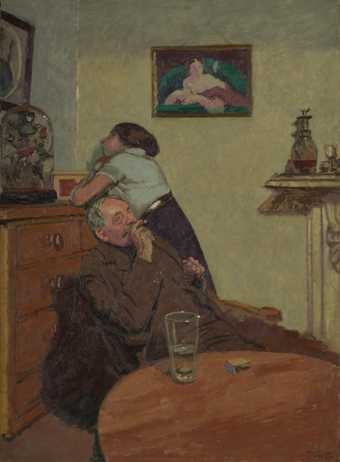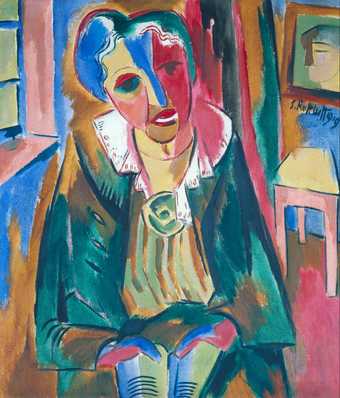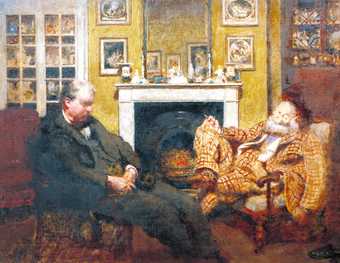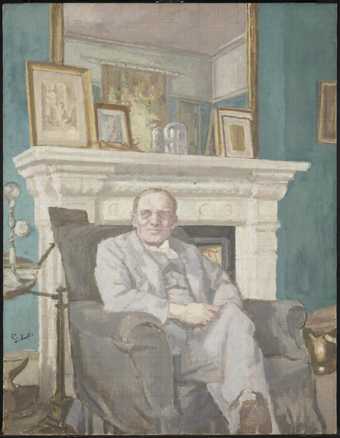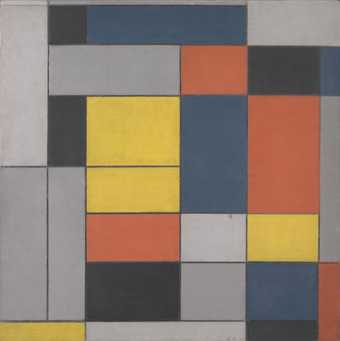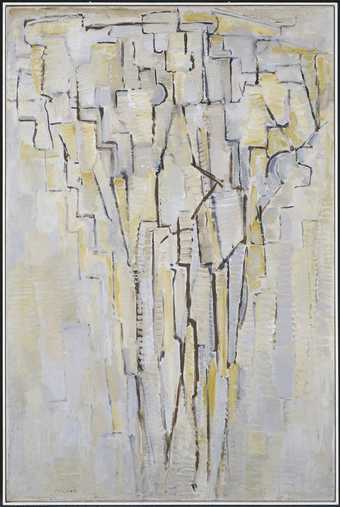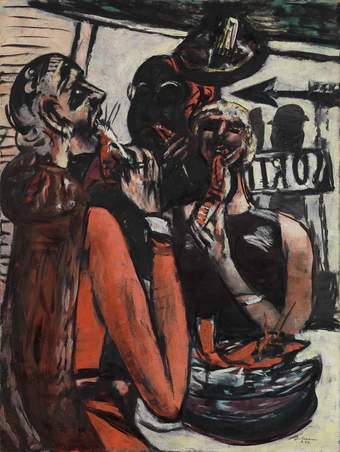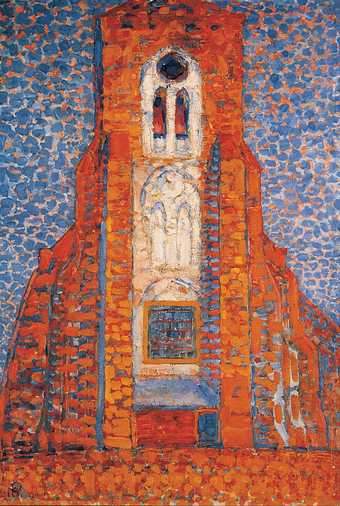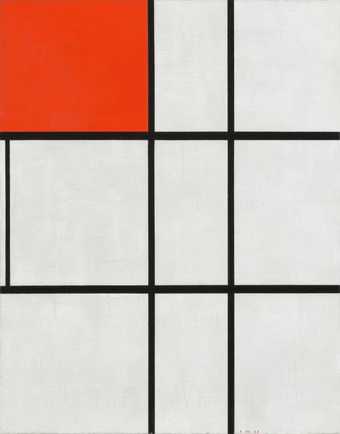
In Tate Modern
- Artist
- Max Beckmann 1884–1950
- Original title
- Fastnacht
- Medium
- Oil paint on canvas
- Dimensions
- Support: 1864 × 918 mm
frame: 2067 × 1130 × 72 mm - Collection
- Tate
- Acquisition
- Purchased with assistance from the Art Fund and Friends of the Tate Gallery and Mercedes-Benz (U.K.) Ltd 1981
- Reference
- T03294
Display caption
This work captures the climax of carnival season in Germany. A period of fancy-dress parties, masked balls and street processions. The two standing figures are based on close friends of the artist. The masked clown on the floor is thought to be Beckmann himself.
The Nazis did not approve of Beckmann’s work. They dismissed the distortions of his figures as ‘degenerate’ art. In 1933 the Nazi government removed Beckmann from his teaching post in Frankfurt. Several of his works were also included in their 1937 Degenerate Art show, prompting him to leave Germany for Amsterdam.
Gallery label, July 2019
Does this text contain inaccurate information or language that you feel we should improve or change? We would like to hear from you.
Catalogue entry
T03294 CARNIVAL 1920
Inscribed ‘Beckmann/F.20’ top right
Oil on canvas, 73 3/4 × 36 1/8 (186.2 × 91.8)
Purchased from Klaus Hegewisch (Grant-in-Aid) with assistance from the National
Art-Collection Fund, Mercedes-Benz (U.K.) Ltd and the Friends of the Tate Gallery 1981
Prov: I.B. Neumann, Berlin (later New York), 1920; private collection; Galerie Axel Vömel, Dusseldorf; Günther Franke, Munich, 1938; Klaus Hegewisch, Hamburg, 1971
Exh: Max Beckmann Ausstellung, I.B. Neumann, Berlin, 1921 (12); Max Beckmann, Kunstverein, Frankfurt, April–May 1921 (14); Neue Secession
(seventh exhibition), Glaspalast Westflügel, Munich, 1921 (13); Max Beckmann: Gemälde der Jahre 1917–1923 und Graphik, Paul Cassirer, Berlin, January 1924 (no catalogue); Ausstellung neuer deutscher Kunst, Kunstgebäude am Schlossplatz, Stuttgart, May–August 1924 (16); Ausstellung Max Beckmann, Kunstverein, Frankfurt, October–November 1924 (2); Internationale Kunstausstellung, Kunsthaus, Zurich, August–September 1925 (24); Max Beckmann. Das gesammelte Werk: Gemälde, Graphik, Handzeichnungen aus den Jahren 1905 bis 1927, Städtische Kunsthalle, Mannheim, February–April 1928 (58); Max Beckmann, Galerie Alfred Flechtheim, Berlin, April–May 1928 (9); Max Beckmann: Gemälde aus den Jahren 1920–1928, Graphisches Kabinett Leitung Günther Franke, Munich, September–October 1928 (1); Max Beckmann, Kunsthaus Schaller, Stuttgart, November 1928 (no catalogue); Max Beckmann-Ausstellung, Graphisches Kabinett Günther Franke, Munich, July 1930 (34); Max Beckmann, Kunsthalle, Basle, August 1930 (21); Max Beckmann: Gemälde und Graphik 1906 bis 1930, Kestner-Gesellschaft, Hanover, January–February 1931 (5); Max Beckmann, Günther Franke, Stuck-Villa, Munich, June–August 1946 (79); Max Beckmann: Gemälde, Kunstverein, Hamburg, May 1947 (no catalogue); Max Beckmann, Städelsches Kunstinstitut, Frankfurt, June–July 1947 (6); Max Beckmann, Kestner-Gesellschaft, Hanover, February 1949 (4); Max Beckmann (Bilder der Sammlung Günther Franke), Würtembergische Staatsgalerie, Stuttgart, December 1950–January 1951 (no catalogue); Gedenkraum für Max Beckmann, Galerie Günther Franke, Munich, February 1951 (3); Max Beckmann: Gemälde und Graphik aus der Sammlung Günther Franke, München, Museum Folkwang, Essen, April–May 1951 (3); Max Beckmann zum Gedächtnis 1884–1950, Haus der Kunst, Munich, June–July 1951 and Schloss Charlottenburg, Berlin, September–October 1951 (29); Gemälde und Graphik aus der Sammlung Günther Franke, München: Max Beckmann, Mensch und Maler, Kunstverein, Freiburg, June–July 1952 (2); Max Beckmann 1884–1950, Kunsthaus, Zurich, November 1955–January 1956 (8); Ausstellung Max Beckmann, Kunsthalle, Basle, January–February 1956 (8); Max Beckmann, Gemeente Museum, The Hague, March–May 1956 (5); Max Beckmann: Gemälde, Zeichnungen, Graphik, Sammlung Günther Franke, München, Wallraf-Richartz-Museum Kölnischer Kunstverein, Cologne, March–May 1959 (3, repr.); Art in Revolt: Germany 1905–25, Marlborough Fine Art, October–November 1959 (33, repr.); Sammlung Günther Franke: Gemälde, Zeichnungen, Druckgraphik, Städtische Galerie, Munich, September–November 1960 (10); Max Beckmann: Sammlung Günther Franke, München, Museen für Kunst und Kulturgeschichte, Lubeck, March–April 1961 (3, repr.); Max Beckmann. Das Portrait: Gemälde, Aquarelle, Zeichnungen, Badischer Kunstverein, Karlsruhe, August–November 1963 (18, repr.); Max Beckmann: Bildnisse aus den Jahren 1905–1950, Galerie Günther Franke, Munich, February–April 1964 (4,repr.); Documenta III: Malerei, Skulptur, Alte Galerie, Kassel, June–October 1964 (II, p.6); Vom Impressionismus zum Bauhaus: Meisterwerke aus deutschen Privatbesitz, Kunstverein, Frankfurt, June–August 1966 and Kunsthalle, Hamburg, August–October 1966 (1, repr.); Max Beckmann, Musée National d'Art Moderne, Paris, September–October 1968 and tour to Haus der Kunst, Munich, November 1968–January 1969 and Palais des Beaux-Arts, Brussels, January–March 1969 (17, repr.); Max Beckmann, Marlborough Fine Art, November 1974 (8, repr.in colour); Tendenzen der Zwanzigen Jahre: Neue Wirklichkeit-Surrealismus und Neue Sachlichkeit, Grosse Orangerie, Schloss Charlottenburg, Berlin, August–October 1977 (4/9, repr.in colour); Paris-Berlin 1900–1933, Centre Georges Pompidou, Paris, July–November 1978 (repr.in colour); Neue Sachlichkeit and German Realism of the Twenties, Hayward Gallery, November 1978–January 1979 (3)
Lit: Guido von Kaschnitz, ‘Max Beckmann’, Der Ararat, 1921, pp.275–8, repr.p.276 (as ‘Zirkus’); Benno Reifenberg, ‘Max Beckmann’, Ganymed, III, 1921, pp.47–8, repr.opp.p.40 (reprinted in von Erffa and Göpel, ed., Blick auf Beckmann: Dokumente und Vorträge, Munich 1962, pp.107–8 and see p.247); Curt Glaser and others, Max Beckmann, Munich 1924, p.77, repr.pls.27 and 28 (detail); Carl Einstein, Die Kunst des 20. Jahrhunderts, Berlin 1926, p.567, repr.; William Hausenstein, ‘Max Beckmann’ in Max Beckmann: Gemälde aus den Jahren 1920–1928 (exh. catalogue), Günther Franke, Munich, 1928, n.p.; Bruno E. Werner, ‘Max Beckmann’, Zeitschrift für Kunst I, no.1, 1947, p.69; Benno Reifenberg and Wilhelm Hausenstein, Max Beckmann, Munich 1949, no.174, p.68, repr.pl.22; Armin Kesser, ‘Das mythologische Elementim Werk Max Beckmanns’ in von Erffa and Göpel, ed., Blick auf Beckmann: Dokumente und Vorträge, Munich 1962, p.27; Eleanor Anderson, ‘Max Beckmann's Carnival Triptych’, Art Journal, XXIV, Spring 1965, pp.219–20, repr.fig.2; Frederick Zimmermann, Beckmann in America, New York 1967 (privately printed), pp.12, 17; Charles S. Kessler, Max Beckmann's Triptychs, Cambridge, Mass., 1970, pp.2, 65, 159–60, repr.pl.10 (as ‘Mardi Gras’); Doris Schmidt, ed., Briefe an Günther Franke: Porträt eines deutschen Kunsthändlers, Cologne 1970, pp.24, 38–41, repr.in colour pl.1; Friedhelm Wilhelm Fischer, Max Beckmann: Symbol und Weltbild, Munich 1972, pp.31–7, 73, 84–5, repr.pl.9; Friedhelm W. Fischer, Max Beckmann, 1973, pp.18–28, repr.in colour p.17; Erhard and Barbara Göpel, Max Beckmann: Katalog der Gemälde, Berne 1976, vol.I, no.206, pp.146–8, repr.vol.II, pl.75; Max Beckmann: Pierrette und Clown 1925 (exh. catalogue), Kunsthalle, Mannheim, 1980, p.47, repr.p.59; Richard Calvocoressi, ‘Beckmann's “Carnival”: A New Acquisition for the Tate’, Burlington Magazine, CXXIV, 1982, p.557, repr.fig.1
Repr: Max Beckmann, I.B. Neumanns Bilderhefte, Berlin, April 1921, p.32; Stephan Lackner, Max Beckmann, New York 1977, p.16 (as ‘Costume Party’); National Art-Collections Fund Review 1983, 1983, p.89 in colour; The Tate Gallery: Illustrated Biennial Report 1980–82, 1983, p.37 in colour
The German title of this painting, ‘Fastnacht’, usually translated as ‘Carnival’ but sometimes as ‘Mardi Gras’, refers to the costume festivities held in the week preceding Lent, culminating on Shrove Tuesday, in Catholic areas of central and southern Germany. It is the first of many pictures in Beckmann's work on the theme of dressing-up and masquerade. In common with most other paintings executed during his Frankfurt years (1915–33), ‘Carnival’ is inscribed with the letter ‘F’ between the artist's signature and its date.
The two standing figures are Israel Ber Neumann, Beckmann's art dealer, and Fridel Battenberg, who in reality never met. Fridel Battenberg features in several works by Beckmann, especially between 1915 and 1920. Her husband Ugi Battenberg had been a fellow student of Beckmann's at the Weimar Art Academy (1900–3), and it was with the couple in Frankfurt-am-Main that the artist went to live after his discharge from the German Army Medical Corps, as the result of a nervous breakdown, in 1915. He stayed until 1919, when the Battenbergs moved flat, but retained his studio on the top floor of the building (Schweizer Strasse 3).
Neumann is dressed as a Harlequin, while Fridel wears the clothes of a Pierrette. However, it has been pointed out by Erhard and Barbara Göpel (op.cit., vol.I, p.174), in connection with a later ‘Fastnacht’ picture by Beckmann, that the terms Pierrot, Pierrette and Clown are more or less arbitrary and interchangeable designations for fancy dress. According to tradition, the horn or trumpet, which the figure in an animal mask at the couple's feet grips between his toes, was used to announce the appearance in the carnival procession of the Harlequin, followed by his clowns.
The masked figure lying on the floor is generally believed to be Beckmann himself, who is the subject of two important ‘Fastnacht’ paintings of 1925 (Göpel 236 and 240) dressed in carnival costume, together with his second wife Mathilde Q. Beckmann. In the first of these, the artist, his head and face covered except for the eyes, adopts a posture almost identical to that of the clown in the Tate's picture, with legs thrust vertically in the air. Closer in date to T 03294 are ‘Self-Portrait as Clown’ (Göpel 211) and ‘Variété’ (Göpel 213), both of 1921. In the latter, a figure wearing an animal mask and polkadot costume resembling those worn by the clown in the Tate's painting stands at the extreme left of the action; a horn sticks out from under his cloak. Finally, in ‘Self-Portrait as Clown’ Beckmann paints himself seated in a chair holding a mask and a slapstick and balancing a bugle or horn on his knees.
The slapstick (‘Narrenpritsche’) has been described by Zimmermann (op.cit) as ‘a long sheet of paper folded in fan-like pleats and carried by harlequins at carnival time. It was used for hitting passers-by and in spite of the loud noise which it made, the blows were harmless’. In ‘Carnival’, both Neumann and the Beckmann-clown figure are holding slapsticks. Fridel Battenberg carries a fan which, in one of the studies for the painting (British Museum), is shown opened out. In her other hand she clasps a fiddle, alluding to her musical talent, and behind her on the window-sill sits one of her cats, with whom Beckmann usually portrayed her.
Two Beckmann attributes can be deciphered. A box of cigars with the letters HAV (anna) inscribed on its side lies open on the table behind Neumann, and an ice bucket containing (Cha)BLI(s) and possibly champagne is shown tumbling to the floor, dragged by the white cloth which the clown has presumably pulled from the table. Visitors to Beckmann at this period would notice his fondness for large cigars and champagne. Other emblematic objects in the painting include a mirror and snuffed candles (both conventional ‘Vanitas’ symbols), and a wind-up gramophone, all of which recur frequently in Beckmann's work of the 1920s.
Stephan von Wiese, in Max Beckmanns zeichnerisches Werk 1903–1925 (Dusseldorf 1978), records seven studies and a further uncatalogued sketch for the painting, which turns out to be closely related to von Wiese 437. A ninth sketch, similar to von Wiese 438, has recently been identified by Sarah O'Brien Twohig in a private collection in New York. Preliminary drawings also exist for other large figure compositions of the period, such as ‘The Night’ 1919 and ‘The Dream’ 1921. Five of the sketches for ‘Carnival’ from the Reinhard Piper collection were auctioned by Karl and Faber at Munich in June 1981. One of these (von Wiese 436; Karl & Faber auction catalogue 156, lot 139, repr.), is now in the British Museum, Department of Prints and Drawings.
The composition of ‘Carnival’ is based on a wing of the St Kilian's altarpiece at Münnerstadt by Veit Stoss, which Beckmann knew in reproduction from Curt Glaser's Zwei Jahrhunderte deutsche Malerei (Munich 1916, p.152). Beckmann's passion for late Gothic art is well documented: Hausenstein, for example, specifically mentions the influence of Veit Stoss, although not in connection with ‘Carnival’ (Reifenberg and Hausenstein, op.cit., 1949, p.35). Beckmann follows Stoss in the placing of the window and in the arrangement of the central figures. There are further echoes, particularly in the tilted architecture and shallow space, and in the expressive or symbolic hand gestures of the figures. The main difference is the presence of the clown lying on the floor, a detail for which there is no prototype in Stoss.
Von Wiese 434 and 435 are the nearest to the finished painting. Other drawings in the series depict clowns, sometimes as many as four, hitting each other with slapsticks or wooden swords. Von Wiese 437 (Kunsthalle, Bremen) is the most violent and chaotic. Musical instruments make their first appearance in von Wiese 438, while von Wiese 439 would appear to portray the aftermath of the fighting, complete with casualty.
Published in:
The Tate Gallery 1980-82: Illustrated Catalogue of Acquisitions, London 1984
Explore
- architecture(30,960)
- domestic(1,795)
- music and entertainment(2,331)
-
- carnival(20)
- commedia dell’arte(23)
- characters(438)
- clothing and personal items(5,879)
- record player(19)
- drink, wine(58)
- mirror(241)
- candlestick(53)
- slapstick(1)
- Battenberg, Fridel(1)
- Beckmann, Max(116)
- Neumann, I.B.(1)
- individuals: female(1,698)
- individuals: male(1,841)
- self-portraits(888)
- dress: fantasy/fancy(506)
-
- fancy dress / role play(182)
- harlequin(11)
- abstract concepts(119)
- arts and entertainment(7,210)
-
- art dealer(328)
- artist, painter(2,545)
You might like
-
Walter Richard Sickert Ennui
c.1914 -
Karl Schmidt-Rottluff Dr Rosa Schapire
1919 -
Henry Tonks Sodales - Mr Steer and Mr Sickert
1930 -
Walter Richard Sickert Sir Alec Martin, KBE
1935 -
Piet Mondrian Composition with Yellow, Blue and Red
1937–42 -
Piet Mondrian No. VI / Composition No.II
1920 -
Piet Mondrian The Tree A
c.1913 -
Max Beckmann Prunier
1944 -
Hilde Goldschmidt The Sphinx
1948 -
Piet Mondrian Sun, Church in Zeeland; Zoutelande Church Facade
1909–10 -
Piet Mondrian Composition B (No.II) with Red
1935

